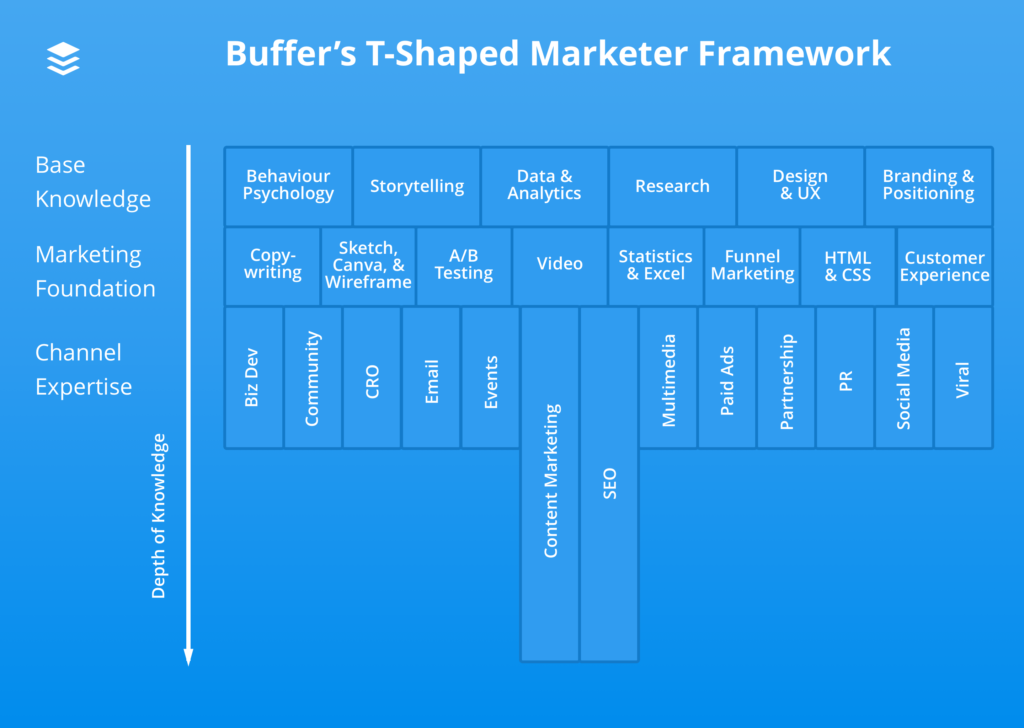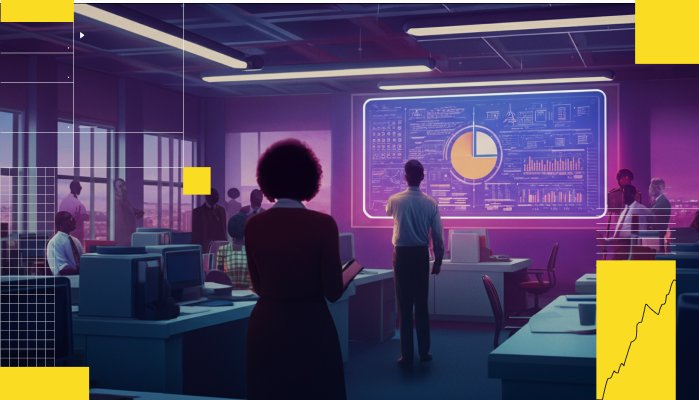Does your in-house team really need agency help?
Research says you do.
According to a 2019 survey, in-house teams experience a 15% decrease in productivity and an 11% falloff in creativity. As the Great Resignation continues, enterprises struggle to find the talent and support they need.
This is no good.
There’s an easier way to strengthen your in-house team’s performance, boost productivity, and increase returns. Looking at the benefits you stand to gain from an agency + in-house team-up is a no-brainer.
Here’s the problem: Enterprises don’t believe agencies can navigate silos and internal politics, manage organizational priorities, or marshal talent consistently.
Are they right?
Are agencies unequipped and unprepared for these challenges? Or are there more compelling reasons to take a deeper look at this team-up?
Let’s take a look.
Why an in-house and agency team-up makes sense
Your in-house team struggles to perform. They face a certain amount of challenges that complicate progress.
What sort of challenges?
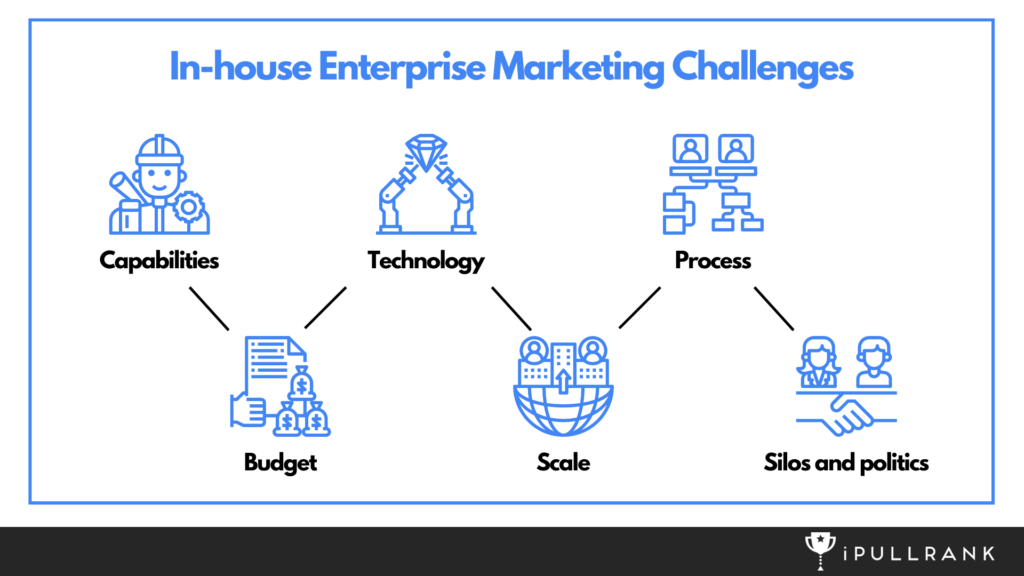
- Capabilities: Many in-house teams lack the skills, experience, or know-how to produce consistent results. In-house teams can develop their own roster of talent, but it’s difficult to keep that know-how in-house as employees move on, move up, or move laterally. An agency team-up means you have the consistent know-how you need to train and re-train key employees.
- Budget: In-house teams are occasionally viewed as a cheaper alternative to agencies; in reality, an in-house team is significantly more expensive than its agency counterpart. In-house teams can be more affordable if the scale of the project or campaign is within your team’s current capabilities or if you have the bandwidth. However, an employee that’s paid $66K per year can’t produce the same quality and quantity of work as an agency can for the same price. In-house teams often don’t have the budget they need to achieve the results they’re looking for.
- Technology: It’s not uncommon for established agencies to spend $50K to $100K on technology (e.g., apps, licensing, training, support, etc.). They also spend a significant amount of time training their employees to manage their projects and campaigns. These resources are typically outside the budget or purview of in-house teams. They simply don’t have the budget, time, or experience to work with these indispensable tools. So most don’t bother.
- Scale: Does your in-house team have the ability to scale your marketing content? Let’s say you’re chasing a competitor who produces 3x as much content as your in-house team. Do you have the people, resources, processes, and tools you need to keep up with the demands? These competitive demands could be link building, content production, budget demands, persona-driven keyword research, lead nurturing, etc.
- Process: What sort of marketing protocols, policies, or procedures should be implemented to achieve the outcomes management has in mind? Agency team-ups are great for two reasons (1.) Agencies iterate rapidly; they’re forced to consistently identify what works for clients. (2.) In-house teams have a deep and intimate knowledge of their core business. An agency/in-house team-up means in-house teams can create the systems and procedures needed to produce consistent outcomes.
- Silos and politics: Sophisticated agencies realize they’re an intermediary – they work with various teams/departments and navigate the silos and internal politics to create structure.
These issues are tough for in-house teams to deal with.
So what?
These challenges aren’t insurmountable; they can be addressed without an agency, right?
Sure.
These challenges can be resolved, provided that you’re willing to accept the consequences and steep learning curve that come with these challenges. For example, developing your own process means a significant amount of trial and error, financial loss, and general failure. If you’re going to overcome these challenges, you’ll need to address them systematically, independent of any silos, turf wars, or internal politics present in the organization.
How an agency helps you strengthen your in-house team
A good agency is T-shaped. Imagine the agency version of this T-shaped marketer by Buffer.
Your agency is filled with highly skilled talent for a broad category of tasks (e.g., SEO, copywriting, data analysis, etc.) but also experts (top 10% in the industry) within a specific area or specialty. What’s exceptional about an agency is the fact that these skillsets overlap.
Agency employees rely on each other as a means of survival.
That sounds dramatic.
But it’s absolutely the case – enterprise clients have steep and unquenchable expectations (as they should). Each campaign is implicitly expected to be better than the last, and quarterly results are expected to go in one direction; up and to the right.
So how do agencies strengthen their client’s in-house teams?
Agencies make your enterprise faster
Your enterprise is slow. It’s no secret.
Ian Miell outlined this problem precisely in his Polygon of Enterprise despair
The enterprise is bogged down by bureaucracy.
The decision-making process is complex and messy, not because enterprise teams are incompetent or messy, but because they’re attempting to coordinate decisions, tasks, and activities with thousands of other people around the world, spread out in different time zones and a variety of cultures.
All of these groups have their own internal politics, their own turf wars, and their own set of macro, meso, and micro goals and objectives.
Here’s why an agency is perfect for the enterprise.
There’s an outsider responsible and accountable.
Miell uses a tangential example: “This …explains enterprises’ love of vendor software over pure open source. If you’ve paid someone to maintain and support a technical stack, then they become responsible for that whole stack. That doesn’t solve all your problems (you still will need to integrate their software with your IT infrastructure, and things get fuzzier the closer you look at the resulting solution), but from a governance point of view, you’ve successfully passed the buck.“
But why is this significant?
Miell explains, “This ownership results in ‘one-throat-to-choke‘ for audit functions.”
One-throat-to-choke? Not the best analogy. Pretty awful, but what’s Miell getting at?
“Much like the police will go after the drug dealer rather than the casual user, the audit functions of an enterprise will go after the formally responsible person or team than the (potentially thousands of) teams using an outdated version of a particular technology. There’s richer pickings there. From ownership comes responsibility. A lot of the political footwork in an enterprise revolves around trying to not own technologies.“
Your agency is there to be held accountable.
Not because they’re eager or excited to dive headfirst into litigation, but because they know the shark-infested waters you live in. They understand the reality that you’ll have to jump through many hoops to get things done.
This is why your agency makes you faster.
Your in-house team uses your agency to bypass all the red tape, the bureaucracy that slows your enterprise down. If you’re working with an agency and they have ownership, they’re the lightning rod that absorbs any vitriol or disdain that would normally be thrown your way.
The credit? Not so much.
Avis received the credit for its “We try harder” campaign.
Source: Denver Post
Who received the blame for the “Deserve to Die” campaign when it triggered outrage?
Source: Lung Cancer Alliance
That’s right; it was their agency, Laughlin Constable.
When your agency and in-house teams work together, you can avoid the polygon of enterprise despair. Your agency gives you the speed you need to move quickly. Agencies accomplish this by:
- Staffing up or down rapidly with an established network of employees, freelancers, near-shore, off-shore, and contract talent
- Relying on a set of systems and procedures to quickly augment the reach, capabilities, and know-how of agency employees and in-house teams
- Providing standardized reporting that’s based on a range of predetermined KPIs and metrics, aiming attention on the most important details
- Using a full suite of updated, industry-leading tools
This speed comes from the knowledge gained, the professionals in your agency’s network, and the decreased red tape and bureaucracy. It’s a win all around.
Agencies get your data right; they tie data to goals and performance
This isn’t as intuitive for enterprises as you might think.
This is where a data-driven agency shines. The research backs this up. According to McKinsey, “Intensive users of customer analytics are 23 times more likely to clearly outperform their competitors in terms of new-customer acquisition than non-intensive users, and nine times more likely to surpass them in customer loyalty.
Our survey results also show that the likelihood of achieving above-average profitability is almost 19 times higher for customer-analytics champions as for laggards. Even more impressive is their likelihood of migrating an above-average share of customers to profitable segments, at 21 times that of non-intensive users of customer analytics.” – emphasis added
More data is not better.
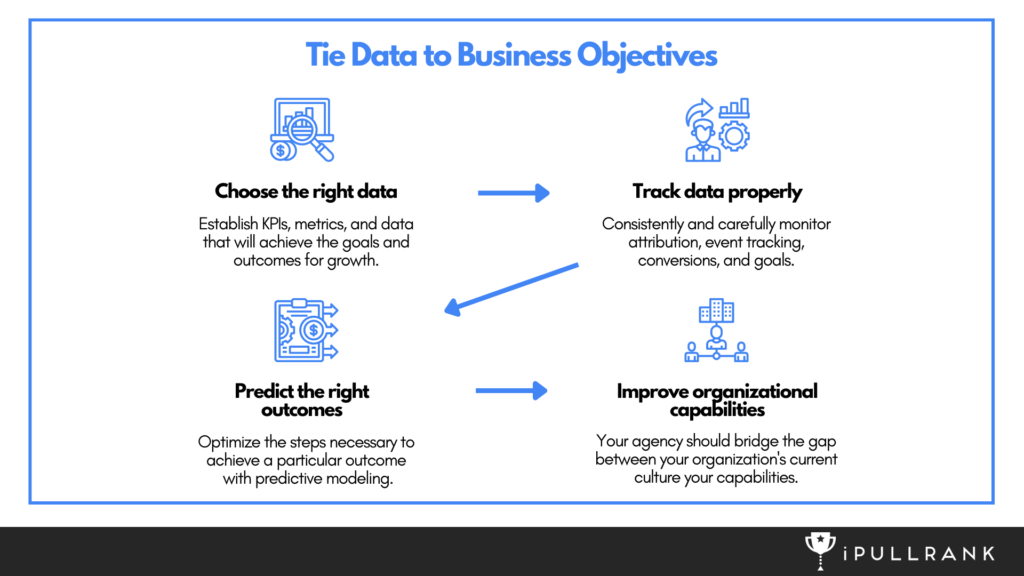
Your enterprise will need clear guidance on:
- Choosing the right data means establishing the KPIs, metrics, and data that will achieve the goals and outcomes your division and organization needs to grow. Simplicity is key here; when data is used properly, it points your team’s attention in the right direction.
- Tracking data properly: Simple habits like good code hygiene mean you’ve taken the appropriate steps to collect data across all touchpoints properly. Attribution, event tracking, conversions, goals, everything is monitored carefully and consistently. Closed-loop analytics is easier with an agency that knows how to navigate the political environment and silos present in your organization.
- Predicting the right outcomes: You’ll need to be able to accurately predict and optimize the steps necessary to achieve a particular outcome (i.e., optimizing traffic, conversions, and revenue from a specific source). Performance improvements and competitive advantages come from predictive modeling. Your agency should be able to help you predict and optimize outcomes using your data.
- Improving organizational capabilities: Your agency should be able to bridge the gap between your organization’s current culture vs. the capabilities you need to achieve stellar results. Your organization will need assistance transitioning from where you are to where your team needs to be. As you’d expect, this is difficult, but it’s much easier if you have help.
Why your data should be tied to your goals
Since politics, silos, and turf wars are a thing, you’ll probably deal with poaching. You know, other teams looking to steal the credit for your hard work.
We all know it’s happening.
Each department wants to maintain its current budget and earn a fat increase for next year. Agencies working with other departments are also looking for a bigger slice of the pie. They’re more than willing to take credit for the work you and your agency have done together.
You hate to see it.
This is incentive enough for many in-house teams. Choose the right data, track it appropriately then, and act on it. It’s straightforward, but it’s amazing how often this is ignored in practice.
Agencies identify team gaps and help fill roles
The Great Resignation means there’s less talent to choose from. Even worse, the enterprise isn’t as attractive to fresh, new candidates, so many enterprises decide to hire internally, placing unqualified people in roles that may not be a good fit.
That’s a problem.
You need people to fill out your in-house roster. You’ll need to determine that each candidate is affordable, has the expertise and core competencies you need, and that they’re a good culture fit. That’s difficult to achieve, especially in today’s market.
This is tough for enterprises.
When it comes to identifying team gaps or filling roles, enterprises often struggle with unknown unknowns. They don’t know what they don’t know. This becomes a bigger problem when you realize many of the professionals in leadership don’t actually know how to identify or recruit the roles needed for the organization.
They don’t know how to identify team gaps.
Christopher Hart, Executive Director of Client Strategy at iPullRank, outlined the problem.
“These executives are unsure about the roles they need to fill. At some point, they decide to put something up on LinkedIn or a few job boards. When they’ve given up, they go to their recruiter, who has less experience than they do (unless they’re a specialist).
Enterprises don’t understand the interconnectivity of these roles.
As a result, they place these roles in poor hierarchical structures that create conflicts and efficiency issues. This makes it harder for teams to work together.
The technical SEO for a division (inside the organization) isn’t centralized with all other Technical SEOs for the division, so they’re not scaling appropriately. They’re all fighting for individual time with developers, so they’re not grouping similar projects together.
They’re not communicating at all.
Leveraging the brand value across the enterprise is a gift, but it also takes effort for divisions to work together to share their divisional value.”
The problem?
Enterprises aren’t promoting T-shaped employees to leadership roles.
They should be promoting people who are both highly skilled at a broad category of tasks (e.g., SEO, copywriting, data analysis, etc.) but who are also experts with deep expertise (top 10% in the industry) within a specific area or specialty. As Hart puts it, “specialists who can have generalist conversations with other specialists.”
Instead, they’re promoting I-shaped employees to T-shaped roles.
These employees have deep expertise in a particular area but lack the broad knowledge they need to manage or lead their divisions effectively. It’s no surprise then that these all-star employees are suddenly poor performers. You know what this leads to, right?
Turnover.
Employee churn.
Your agency isn’t simply a group of timekeepers who track time to tasks.
They’re advisors.
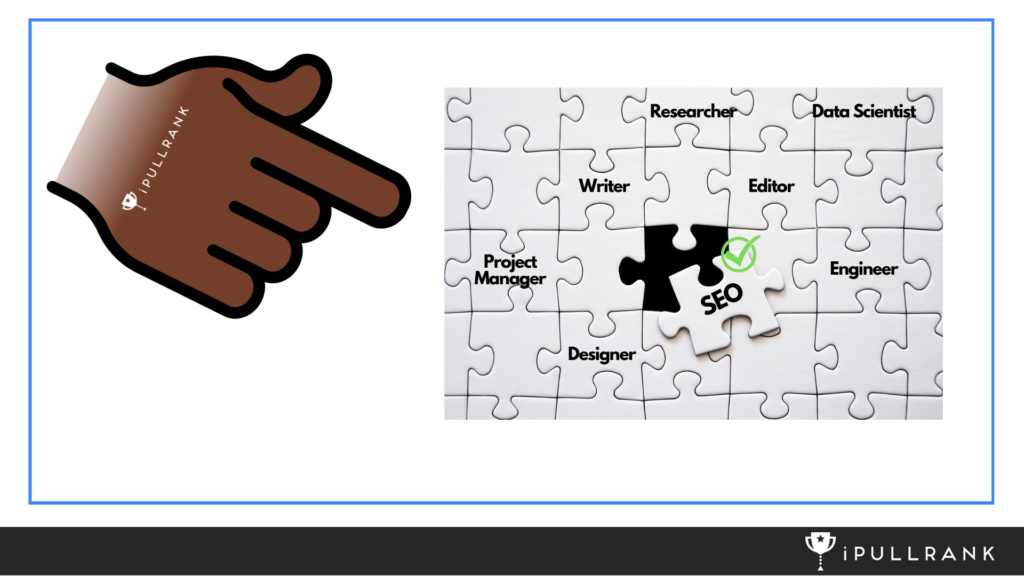
If you’re building or optimizing your in-house team, you’re going to need to:
- Identify the roles that are missing (or incomplete)
- Create the roles you need
- The amount of revenue you expect a seasoned or trained professional in this role to carry
- Define each role (i.e., job descriptions, full-time/part-time)
- Outline the desired experience, skills, and expectations for the role
- Curate the resources and training materials for each role
- Create a governance plan that clearly defines the who, what, where, when, and how
It’s about keeping the framework as simple as possible; you’ll also need someone to chase down the answers to these questions, reaching out to various professionals and stakeholders in other departments.
It starts with some simple questions.
- What kind of goals or outcomes are we looking for?
- Do we have the people, processes, products, and budget to achieve that?
- What are we missing? (e.g., process, products, people, budget, etc.)
- Who do we need? (roles)
- What do we need them to do?
- How do we want them to do it?
- What resources do they need to accomplish the goals or outcomes we’ve set?
- Who will these roles report to?
- How long will it take to accomplish these goals and outcomes?
I know, this sounds obvious.
Believe it or not, many organizations don’t have a governance plan in place. The good news is this is entirely fixable. If your agency partner is experienced, they’ll have the framework your organization needs to make this happen.
Schedule a call with iPullRank and we can discuss your structure, needs, and strategy.
What about governance?
If you’re planning on building a large, in-house content team, for example, you’ll want to create a content governance plan. A governance plan (as defined in my previous post) is,
A system you use to manage your content. Your governance plan dictates how your organization creates, publishes, promotes, and manages content. This plan outlines your goals and objectives, defines the roles and responsibilities of your team, and it outlines the workflows used to accomplish results.
The criteria and framework above are a large part of this.
Your governance plan is the blueprint your team needs to perform. With the right plan, your team has a keen understanding of the production process — the roles and responsibilities of each team member, the resources you have available, what you’ll need, and the way work should be done.
It’s an essential component of a successful in-house team.
Agencies advocate for your agenda
Picture this.
Your point of contact at enterprise X believes creating more middle, and bottom-of-funnel content will generate more leads and revenue at a (37%) lower cost per customer. The data shows they’re right; that’s the good news. SEO can produce more revenue with content engineering, content strategy, and some elbow grease. The bad news is this means less budget for the PPC teams.
Naturally, there’s a lot of resistance.
That’s the micro issue.
However, as soon as we zoom out and take a macro–level view of the situation, we see that:
- Management feels there isn’t enough people power (or training) to make that happen.
- The current SEO team, a skeleton crew of five people, doesn’t have the training or the resources they need to implement the proposed plan.
- PPC is viewed by management as a “sure thing” – it’s basically push-button traffic, leads, and revenue.
- There’s this perception that SEO is necessary, but it takes too much time to see traction.
- PPC is the preferred marketing channel.
- It’s rumored that a restructuring may be necessary (down the line) if market conditions continue to degrade.
- The C-suite wants the (seemingly) impossible. More customers (at a lower cost per acquisition), consistently higher CLTVs, and a 16% to 34% increase in revenue by Q4.
Your point of contact happens to be the Director of Search at enterprise X.
This is terrible.
What good is an agency at a time like this?
Quite a bit, actually; your agency can:
- Manage campaigns over a set period as the in-house team is being developed
Staff up/down quickly, addressing any people power issues. - Help HR find, recruit, and hire ideal candidates to build your in-house team.
- Provide your in-house team with the education, training, and resources needed to maximize team performance.
- Set up and provide standardized reporting, offering the right metrics and reports.
- Unite PPC and SEO teams under a common goal (i.e., avoid departmental restructuring and/or layoffs).
- Integrate PPC teams into content marketing campaigns (e.g., promoting evergreen content, integrating offers into content, comprehensive funnel coverage, gathering PPC data for SEO, i.e., conversion keywords).
- Your agency can lean on the SEO and PPC teams to amplify the outcomes from both initiatives. Under your agency’s direction, both teams can maximize your organization’s performance.
- Provide step-by-step direction for SEO and PPC teams, so the organization hits its goals. Shared data from SEO and PPC teams + agency know-how and systems building means both teams win.
- Use shared wins to break through silos, uniting teams in the process.
See what I mean?
Initially, agencies advocating for the agenda sounds sleazy, as if unscrupulous backroom deals are being made. It’s not about that. It’s about managing the various goals and objectives of key players and the organization’s goals overall.
That’s easy to say.
What about internal politics? How can agencies get anything done if they’re unable to navigate workplace politics?
Agencies help you navigate workplace politics
Agencies don’t have a full understanding of the internal politics of your organization. This is a very good thing, especially if it’s discussed with your client point of contact ahead of time.
Why is this an advantage?
Your agency has the freedom to do what needs to be done. They’re unencumbered by the political landscape, so they’re able to move freely and act on your behalf. While this is beneficial, it’s also a double-edged sword. To mitigate these problems, you’ll want to brief your agency on the following:
- What’s required/permissible?
- What requires approval by the client or stakeholders?
- What’s forbidden/unacceptable?
- Stop words and hidden rules that are essential to function.
What sort of politics do agencies help enterprises navigate?
- Status quo beneficiaries and stakeholders who are threatened by change
- Stakeholders who produce lackluster results for the organization but continue to wield significant influence
- The average employee who doesn’t have the knowledge or visibility into decision-making but is expected to embrace the “big picture”
- Organizations where you have to “work the system” to get anything done; the best “players” game the system
- Ongoing power struggles and turf wars as teams, departments, and factions fight for resources, access, and control
- Dealing with political archetypes (e.g., credit poachers, crusaders, brown nosers, gossips, saboteurs, power-thirsty, etc.)
How can agencies help enterprises with these challenges? Agencies can make or recommend institutional change, acting as an unencumbered authority. They can move freely among the various organizational factions vying for control. They can unite teams under a common goal, using desired outcomes and shared goals as motivators.
Here’s why agencies care.
They know doing great work is scratching the surface. These social dynamics need to be addressed, facilitated, and massaged. If they want to keep you as a client, this isn’t optional. As Niven Postma writes for HBR, you can’t sit out workplace politics.
If your agency takes you on, your politics is now their problem.
This isn’t necessarily a bad thing.
Postma writes, “despite all the negative connotations, office politics are not inherently evil. They are about two things: influence and relationships, and the power these two things give you — or don’t.”
Here’s why agency support is so crucial.
Your agency is your contingency plan
Remember the Great Resignation?
The Great Resignation 2022: Where are all the workers?
A record number of people, 47 to 57 million people (link below), voluntarily walked away from their jobs. It’s a mass exodus at levels we’ve never seen before. If you thought, “well, that’s because of the pandemic,” you’d be wrong. Joseph Fuller and William Kerr at HBR made a salient point.
The Great Resignation didn’t start with the pandemic.
In reality, it’s an ongoing trend that’s accelerated over time. Fuller and Kerr had this to say about the Great Resignation.
“The figure — and the numbers — tell a clear story. From 2009 to 2019, the average monthly quit rate increased by 0.10 percentage points each year. Then, in 2020, because of the uncertainty brought on by the Covid-19 pandemic, the resignation rate slowed as workers held on to their jobs in greater numbers. That pause was short-lived. In 2021, as stimulus checks were sent out and some of the uncertainty abated, a record number of workers quit their jobs, creating the so-called Great Resignation. But that number included many workers who might otherwise have quit in 2020 had there been no pandemic. We’re now back in line with the pre-pandemic trend, which is one that American employers are likely to be contending with for years to come.“
How do agencies factor into this?
Competition for A-player talent will be more aggressive. It’s a seller’s market, and these days employees aren’t as eager to stay with employers when they feel they can do better.
Your agency is your contingency plan.
Relying on your agency means you’ll be able to staff up or down with A-player talent. You can outsource your talent needs to your agency, allowing you to deploy campaigns quickly, enter new markets, and focus on your organizational goals. This gives you the breathing room to assess, adapt to, and work with the market.
What if your in-house team needs training?
Relying on your agency to train your in-house team
Your agency is better than you.
This isn’t intended to be insulting or inflammatory. Rather, it’s the unfortunate reality of agency life. Your agency has more experience and deeper expertise because they’re forced to. They exist in a Darwinian ecosystem.
- Competing agencies are eager to poach their clients if they don’t perform
- Clients are quick to leave if their agency fails for any reason
- Pundits will publicly highlight their failure if they fall behind (e.g., best practices, industry updates)
- Clients expect their agency to be more knowledgeable, have more expertise, and understand their business
- Agencies work with dozens of clients at a time in the same (or similar industries). This experience is how they attract, win, and retain new clients
- They rely on hundreds of tools that they use to aggregate, report, or segment data
- Agencies fight to survive feast and famine cycles. This struggle gives them ingenuity and the ability to identify missed opportunities
You see my point though, right?
Agencies are forced to continually analyze, decode, and address the neverending stream of Google algorithm updates. There’s a steady supply of tools and resources, new metrics to follow, and an assortment of rules and criteria you’ll need to follow to maintain compliance. If, at any time, you feel you’ve arrived with you’re training, you’ve already fallen behind.
What does this mean?
Your agency is better than your organization.
If they weren’t better at what they do, your company wouldn’t need them. Agencies are battle-hardened and continually tested. They’re forced to perform while dealing with crises stemming from Google, clients, competitors, or suppliers.
This makes them the ideal trainer.
Their expertise, depth of experience, broad perspective, and resilience under constant pressure mean a good agency is perfectly suited to train your in-house team.
Here’s why that matters.
Here’s the part you probably know; the new employees you’ve added to your in-house team? They’re not profitable. It takes time to achieve full productivity (even with seasoned experts). Your in-house team isn’t a profit center; in the beginning, they’re a cost center.
Here’s the part you may not know.
Many employees never reach full productivity. They continue to operate as a cost center, dragging your team’s performance down with them as they lag behind the rest of the group.
How long does it take to achieve full productivity?
Research from MIT states that it can take anywhere from 8 weeks for clerical roles to 8 months for management roles! That’s longer than we’d prefer, but it’s not so bad, right?
Well, what’s the average employee tenure?
Government data tells us that the average tenure is four years, with the lowest at three years. This doesn’t include costs from disengaged employees and the cost of replacing them when they leave.
What’s my point with all of this?
Your agency can help you to train, recruit, hire, onboard, and support your in-house team. Their suffering is your gain – your employees achieve full productivity faster. Agencies give in-house teams something they don’t already have.
This sounds like a pipe dream.
Can agencies pull this off for a larger enterprise?
Absolutely. Your agency…
- Understands the failure points your in-house team is likely to experience
- Has the know-how needed to quickly create, implement, and scale your systems and procedures
- Can provide your in-house team with the software training and onboarding they need
- Knows how to properly assess team/individual performance across a variety of dimensions
- Can help you to minimize recruitment, promotion, legal, and retention costs, giving you more budget you can funnel into your team
- Knows how to identify and remove a bad hire quickly
Here’s the most important piece of this training puzzle.
Your agency has a formal evaluation system in place. It’s a useful tool they’ll use to objectively evaluate the competency of the in-house employees on your team. They can quickly assess each employee’s capabilities, skills gaps, technical competency, and knowledge.
Sure, you can do this.
But it’s not the same if you don’t have the same level or depth of expertise.
An agency strengthens your in-house team
If you’re part of an enterprise, you may need help.
Enterprises don’t know what they don’t know. It’s a big problem when you realize many of the professionals in leadership don’t actually know how to identify or address the issues we’ve covered today.
Agencies do.
Agencies are forced to endure a trial by fire; their suffering is your gain. Use their expertise to strengthen your in-house team’s performance, boost productivity, and increase returns.
Your agency is better (at what they do) than your organization.
They have to be.
As we’ve seen, agencies can navigate turf wars, silos, and internal politics in your organization while managing organizational priorities and marshaling talent. An agency + in-house team-up is a no-brainer; you get the full breadth of their skills, knowledge, and expertise at a fraction of the price.
Here’s the best part.
Your enterprise avoids the consequences and steep learning curve that comes with an in-house team that’s on their own. Choose the right agency, and you’ll find your team profits from their trials, errors, losses, and failures, no struggle necessary.

